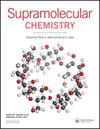Fluorescence probe with AIE properties for ratiometric/turn off detecting of water in organic solvents and solid state
IF 2.6
4区 化学
Q3 CHEMISTRY, MULTIDISCIPLINARY
引用次数: 1
Abstract
ABSTRACT Efficient detection of trace water was important before use in water-sensitive reactions. Herein, a fluorescence sensor 1,4-bis((E)-(2-(benzo[d]thiazol-2-yl)hydrazineylidene)methyl)benzene (DHB) was designed and synthesised by a simple one-step reaction using 2-hydrazinobenzothiazole and terephthalaldehyde as raw materials. DHB showed aggregation-induced emission characteristics in solid state and 1,4-dioxane/H2O mixture. In addition, the fluorescent colour changes in IPA and fluorescence quenching in N,N-dimethylformamide (DMF), N,N-dimethylacetamide (DMA), dimethyl sulphoxide (DMSO), glycerine (GI), and 1,3-propanediol (1,3-PDO) were obviously observed with increasing water content, making DHB a highly sensitive fluorescent sensor for water detection with a detection limit of 0.174% for IPA, 0.040% for DMSO, 0.067% for DMF, 0.039% for DMA, 0.069% for 1,3-PDO, and 0.013% for GI, respectively. Further, DHB displayed fluorescence colorimetric response to water in solid state. 1H NMR titration indicated that the sensing mechanism for the detection of trace water was form hydrogen bonds between H2O molecule and amino group of DHB. Graphical Abstract: A highly sensitive fluorescent probe DHB with AIE characteristics for water detection with a detection limit of 0.174% for IPA, 0.040% for DMSO, 0.067% for DMF, 0.039% for DMA, 0.069% for 1,3-PDO and 0.013% for GI. Further, DHB displayed fluorescence colorimetric response to Al3+ in solid state具有AIE性质的荧光探针,用于有机溶剂和固态水的比例/关闭检测
水敏反应中痕量水的高效检测至关重要。以2-肼苯并噻唑和对苯二甲酸乙酯为原料,通过一步反应合成了1,4-二((E)-(2-(苯并[d]噻唑-2-基)肼基)甲基苯(DHB)荧光传感器。DHB在固态和1,4-二氧六环/水混合物中表现出聚集诱导发射特性。此外,随着水含量的增加,IPA的荧光颜色发生明显变化,N,N-二甲基甲酰胺(DMF)、N,N-二甲基乙酰胺(DMA)、二甲亚砜(DMSO)、甘油(GI)和1,3-丙二醇(1,3- pdo)的荧光猝灭现象明显,使DHB成为一种高灵敏度的水检测荧光传感器,IPA的检出限为0.174%,DMSO的检出限为0.040%,DMF的检出限为0.067%,DMA的检出限为0.039%,1,3- pdo的检出限为0.069%,GI的检出限为0.013%。此外,DHB对固态水表现出荧光比色响应。1H NMR滴定表明,DHB对微量水的传感机制是H2O分子与DHB氨基之间形成氢键。图形摘要:一种具有AIE特性的高灵敏度荧光探针DHB用于水检测,IPA检测限为0.174%,DMSO检测限为0.040%,DMF检测限为0.067%,DMA检测限为0.039%,1,3- pdo检测限为0.069%,GI检测限为0.013%。DHB对固态Al3+表现出荧光比色响应
本文章由计算机程序翻译,如有差异,请以英文原文为准。
求助全文
约1分钟内获得全文
求助全文
来源期刊

Supramolecular Chemistry
化学-化学综合
CiteScore
3.60
自引率
3.00%
发文量
5
审稿时长
2.7 months
期刊介绍:
Supramolecular Chemistry welcomes manuscripts from the fields and sub-disciplines related to supramolecular chemistry and non-covalent interactions. From host-guest chemistry, self-assembly and systems chemistry, through materials chemistry and biochemical systems, we interpret supramolecular chemistry in the broadest possible sense. Interdisciplinary manuscripts are particularly encouraged. Manuscript types include: high priority communications; full papers; reviews, and; Methods papers, techniques tutorials highlighting procedures and technologies that are important to the field. We aim to publish papers in a timely fashion and as soon as a paper has been accepted and typeset it will be published in electronic form on the Latest articles section of the website. The two most important review criteria are that the paper presents high-quality work that fits generally into the broad spectrum of activities in the supramolecular chemistry field. Under normal circumstances, Supramolecular Chemistry does not consider manuscripts that would be more suitable in a highly specialized journal. This includes, but is not limited to, those based mostly or exclusively on topics such as solid state/X-ray structures, computational chemistry, or electrochemistry. .
The two most important review criteria are that the paper presents high-quality work that fits generally into the broad spectrum of activities in the supramolecular chemistry field.
 求助内容:
求助内容: 应助结果提醒方式:
应助结果提醒方式:


